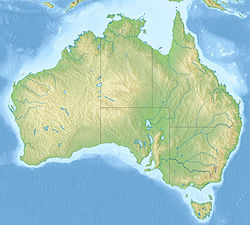| Evergreen Formation | |
|---|---|
| Stratigraphic range: Lower Pliensbachian- Late Toarcian ~ [1] | |
| Type | Geological formation |
| Unit of | Bundamba Group |
| Sub-units | Boxvale Sandstone & Westgrove Ironstone Members |
| Underlies | Hutton Sandstone |
| Overlies | Precipice Sandstone |
| Thickness | Up to 255 m (837 ft) |
| Lithology | |
| Primary | Sandstone, siltstone, mudstone |
| Other | Coal, ironstone |
| Location | |
| Coordinates | 25°48′S150°18′E / 25.8°S 150.3°E |
| Approximate paleocoordinates | 61°42′S90°00′E / 61.7°S 90.0°E |
| Region | New South Wales, Queensland |
| Country | Australia |
| Extent | |
| Type section | |
| Named for | "Evergreen Shales" |
| Named by | Hogetoorn [3] |
The Evergreen Formation is a Pliensbachian to Toarcian geologic formation of the Surat Basin in New South Wales and Queensland, eastern Australia. Traditionally it has been considered to be a unit whose age has been calculated in between the Pliensbachian and Toarcian stages of the Early Jurassic, with some layers suggested to reach the Aalenian stage of the Middle Jurassic, yet modern data has found that an Early Pliensbachian to Latest Toarcian age is more possible. [4] [5] [6] The formation was named due to the "Evergreen Shales", defined with a lower unit, the Boxvale Sandstone, and a partially coeval, partially younger upper unit, the Westgrove Ironstone Member. [7] This unit overlies the Hettangian-Sinemurian Precipice Sandstone, as well several informal units such as the Nogo Beds, and Narayen beds, as well Torsdale Volcanics. [7] This unit likely was deposited in a massive lacustrine body with possible marine environment influences. [8]



























